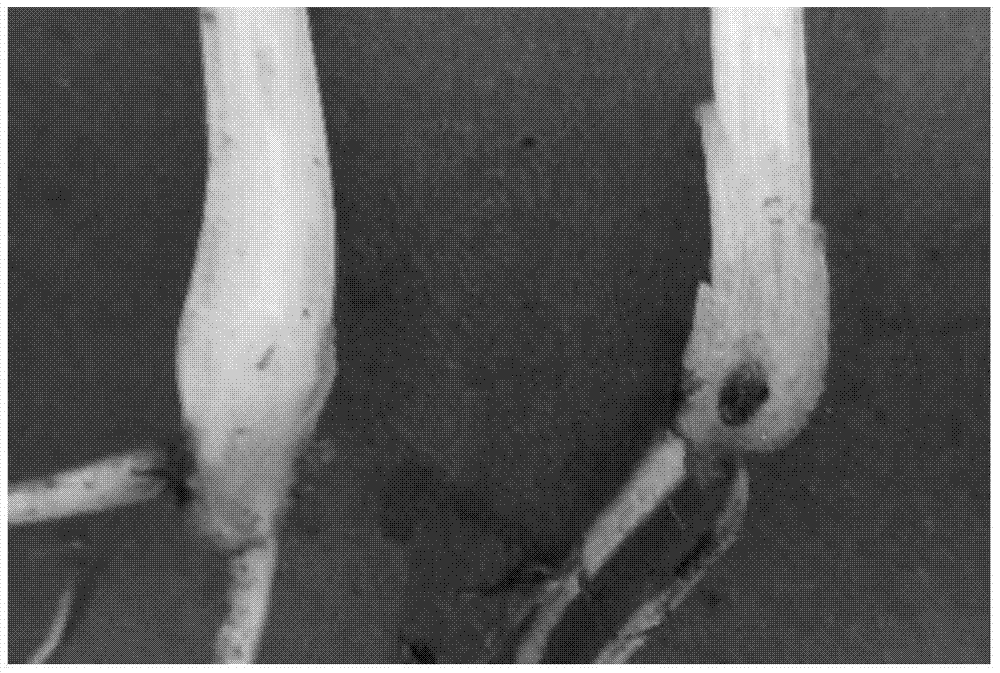Method for detecting pathogenicity of pathogenic bacteria of banana vascular wilt
A technology for banana fusarium wilt and pathogenic bacteria, which is applied in the directions of microorganism-based methods, biochemical equipment and methods, and microbial determination/inspection, etc., and can solve the problems of inaccurate experimental results, high dependence on morbidity, and unfavorable large-scale experiments. , to achieve the effect of convenient observation and simplification of measurement
- Summary
- Abstract
- Description
- Claims
- Application Information
AI Technical Summary
Problems solved by technology
Method used
Image
Examples
Embodiment 1
[0028] Embodiment 1, detect the pathogenicity of banana fusarium wilt pathogen to Brazilian banana
[0029] 1. Preparation of tissue culture seedlings
[0030] 1. Preparation of explants
[0031] Dig the sucking buds of the Brazil banana plant, peel off part of the leaf sheath on the pseudostem, cut off the 2-3 cm long stem tip, soak and wash it with 75% (volume fraction) alcohol water solution for 15 seconds (to kill the germs), soak in 1.5% (mass fraction) sodium hypochlorite or 0.2% (mass fraction) mercuric chloride aqueous solution for 15 minutes, rinse with sterile water for 3 times, and then continue to peel off the remaining leaf sheath leaf by leaf on the ultra-clean workbench. Peel off until the height is 1-1.5 cm and the diameter is 1.2 cm, and then cut the meristem into 4 pieces evenly from the top to the bottom, which is the explant.
[0032] 2. Culture and proliferation of explants
[0033] Inoculate the explants obtained in step 1 into the primary culture medi...
Embodiment 2
[0057] Embodiment 2, detect the pathogenicity of banana fusarium wilt pathogen to powder banana
[0058] 1. Preparation of tissue culture seedlings
[0059] Replace the Brazil banana plant with the powder banana plant, and the method is with the step one of embodiment 1.
[0060] 2. Detection of pathogenicity of banana fusarium wilt pathogen to pink banana
[0061] The experiment site is Haikou City, Hainan Province, and the experiment time is July.
[0062] Replace the tissue-cultured seedlings of Banana braziliana with the tissue-cultured seedlings of the powdered banana prepared in step 1, and the method is the same as step 2 of Example 1.
[0063] The experiment was repeated three times, and 10 banana plantlets were tested in each repeated experiment.
[0064] Through the statistics of the disease index, we can understand the pathogenicity of pathogenic bacteria. The Physiological race 1 of Fusarium oxysporum Cuban specialization can be pathogenic to the banana (the di...
PUM
 Login to View More
Login to View More Abstract
Description
Claims
Application Information
 Login to View More
Login to View More - R&D
- Intellectual Property
- Life Sciences
- Materials
- Tech Scout
- Unparalleled Data Quality
- Higher Quality Content
- 60% Fewer Hallucinations
Browse by: Latest US Patents, China's latest patents, Technical Efficacy Thesaurus, Application Domain, Technology Topic, Popular Technical Reports.
© 2025 PatSnap. All rights reserved.Legal|Privacy policy|Modern Slavery Act Transparency Statement|Sitemap|About US| Contact US: help@patsnap.com

